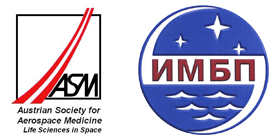The pumping heart products pulse waves that pass through the arteries and arrive at the periphery of the body. The waves’ properties change depending on the vessels’ diameter, elasticity and distance from the heart. The status of the vessels is in turn affected by the emotional status of the person being investigated. Tension and stress also change the pulse rate.
Through the acceleration of the blood in left ventricle’s outflow, the body initiates an equal and opposite impulse, that is, a rebound. The expelled blood – about 100g per heartbeat – has only a low mass compared to the body’s weight. The resulting miniscule movement of the body can only be registered with very sensitive instruments here on earth. Space offers ideal conditions for such measurements because no elastic or braking components interfere with the body’s movement.
The registration of the pulse is mainly used in the diagnosis of heart-circulation diseases, but is also interesting for healthy persons because even body stress and psychic factors lead to changes of the circulation.
Objectives
In the experiment PULSTRANS, results of physiological experiments during a series of long-term space flights measured on the Russian MIR space station were illustrated. For this purpose, data of the longest space-flight carried out so far was used. During the RLF program, a series of short, 4 to 6 long space flights were also carried out. This data was evaluated with the data of previous investigations that was won within the framework of the common Russian-Austrian medical space program.
The question on how the autonomous regulation of the circulation and the heartbeat behaves in the course of a long-term sojourn in weightlessness during the experiments conducted. Weightlessness displays an exceptional state that changes the autonomous nervous system and the circulation regulation in a particular way. The unique occasion to follow these changes for more than a year should be used in this experiment. Additionally, the function of the autonomous nervous system on the synchronisation between the heartbeat and breathing was investigated.
The KYMO and KYMO-II devices were developed for the PULSTRANS experiment together with the MIKROVIB experiment. This consisted of a sensor vest, data collection and recording, and an ergometer.
Functionality, Measuring principle
The PULSTRANS experiment consisted of a series of functional and performance tests that were executed by a pre-defined program in the KYMO device. The first was a gravitation test with various arm positions. The result: The rising of the arm that leads to a fall of pulse wave velocity on earth shows no corresponding effects in weightlessness. The influence of gravitation on this parameter is therefore proven. PULSTRANS delivered a series of further interesting information about changes of the vascular tonus in weightlessness. While the wall tension of the arterial vessels in the lower half of the body is reduced considerably, it increases in the upper half of the body. The peripheral vascular resistance is reduced in flight. The properties of the artery system influence the form and the dispersion of the pulses. The measurement of the pulse wave velocity as well as the analysis of the pulse forms and the pulse deformation can be adducted to the characterisation of the circulation state.
Special sensors were developed in order to measure this processes, satisfying the various demands. They should be very sensitive and less interference-prone. One expected that the cosmonauts would not be encumbered, and at the same time being highly flexible and still have tear-proof cable connections, small measurements and light.
The complete experiment (PULSTRANS) was executed in a day whereby the experiment order was controlled by a micro-processor. The special sensor jacket and a sensor belt were developed for this purpose. A series of sensors for the cosmonauts’ physiological measuring were integrated. A reduced experiment version was carried out whilst sleeping (SLEEP experiment). Data of the cosmonaut were recorded during some nights within the SLEEP experiment, whereby long-term recording of the heart frequency and the vagus tonus as well as breathing and the heart’s ballistocardiogram were done.
The NIGHT experiment was based on a small acceleration sensor that was placed in the cosmonaut’s sleeping bag and connected with the KYMO device, KYMO-2 from RLF-3. This sensor recorded the ballistocardiogram from the heart frequency. The heart frequency variability and the cosmonaut’s movement whilst sleeping could then be calculated.
Shared equipments of the Austrian payload
DATAMIR, KYMO, KYMO-2
Results
Flights with a duration of 4 to 6 months
Heart Frequency
A gradual increase of the median heart frequency was observed in rest 1 and rest 2 as well as in quiet sleep during the whole flight. The increase of the rest value still increased strongly especially in the first 2 to 3 months after start of the flight and it clearly decreased after the end of the flight.
Valsalva and Mueller experiments increased the heart frequency only a little; whereby the heart frequency increase at the end of the third month could be observed compared to the resting heart frequency of the Valsalva manoeuvre.
Vagustonus
The vagus tonus, playing an important role as a defensive factor against sudden heart death and heart attacks, was highest during the second flight month and reduced itself after the flight to lower values than those before the flight. This decrease of the vagus tonus could be observed continuously during the re-entrance into earth gravity and it showed stress that, through the return to gravity, led to a reduction of the vagus tonus in the heart. The return into gravity displayed a strong stress factor and resulted in a reduced vagus tonus during the rest phases as well as a still strongly reduced vagus tonus during the stress through dynamometry.
The Valsalva Experiment showed interesting results: While the vagus tonus barely changed during the Mueller Experiment, it increased in the Valsalva Experiment despite the increase of the heart frequency that was observed simultaneously. The increase of the vagus tonus was strongly distinct in the post-flight examinations.
Ballisto- and seismo amplitudes
The ballistocardiogram amplitudes showed an increase at the beginning of the flight as well as during the resting phases and during the dynamometry. It was very distinct during the dynamometry. The increase reduced to pre-flight values after the flight and even during the second flight month.
A similar effect could also be observed in the seismocardiogram. Albeit the resting amplitudes of the seismocardiogram were not particularly high during weightlessness, the changes during the dynamometry were observed clearly.
Amplitude of the electrocardiogram
The electrical ECG amplitude showed an increase at the beginning of the flight and a further continuous increase up to the end of the flight. Even the individual experiment parts showed little differences during the post-flight phase. The increase observed in the pre-flight phase was not available anymore during or after the flight.
Autonomous control of the heart frequency in overview
The heart frequency increase observed in all experiment phases during the flight could be partially explained through the abatement of the vagus tonus that was found particularly after the flight and in the late flight phases.
Pulse wave velocity
The pulse wave velocity was determined from the time difference of the pulse waves’ arrival times in the carotid artery and the finger and foot pulse arrive time. The pulse wave velocity won, taking into account the artery length, was plotted during the resting phase 1 and 2 for the finger and foot arteries. It shows that the pulse wave velocity in the arm arteries is about 5 to 6 m/sec and is similar to the pulse wave velocity in the leg arteries. A clear increase of the resting pulse wave velocity was observed in the arm and leg arties during both resting phases after the second flight month.
Ultra long-term flight 14 months long
Heart frequency
During the resting phase, the heart frequency of the cosmonaut Dr. Poljakov was largely stable. A noticeable increase was observed only after the flight. The increase of the heart frequency that amounted to only 30% of the other cosmonauts’ prevailing measures, decreased again after a momentarily high during the course of the flight. Hence, the autonomous flexibility was also reduced in this experiment and was noticeable particularly after the flight. The Valsalva and Mueller experiments show very few changes of the heart frequency particularly around the end of the flight.
Vagustonus
A low vagus tonus despite relative low heart frequency was continuously observed on the cosmonaut Dr. Poljakov. The vagus tonus increased to astonishing high values only during sleep, whereby it sank again to daily values around the end of the flight and after re-entry back to Earth. This special form of vagus regulation was not observed on other cosmonauts. Only a slight fall of the vagus tonus in the waking resting phase was observed during the course of the flight. Even this regulation is abnormal. The increase basically lied under the values acquired from the other cosmonauts.
Ballisto- and seismo amplitudes
After a starting rise in the second month, an amplitude increase was observed up to the 8th month. The ballistocardiogram values after the flight were similarly high as the pre-flight ones, contrary to what was observed in the seismocardiogram; a significant amplitude rise from seismo 1 and, to a lesser degree, seismo 2. An increase due to the dynamometry was observed on the seismo 1 and seismo 2 amplitudes. This was distinct in the first months of flight, gradually decreasing and disappearing around the end of the flight.
Amplitude of the electrocardiogram
The ECG amplitude increased to 250% of the pre-flight values during the first 6 months. The pre-flight values were reached again around the end of the flight and a very strong decline of the ECG amplitude could be observed after the flight.
Autonomous control of the heart frequency in overview
Heart frequency regulation peculiarities on Dr. Poljakov were already alluded to during the vagus tonus. It also stood out that the values on Dr. Poljakov were also very low for the sympathetic regulation, i.e. the cosmonaut showed abnormal low activity in resting. This could explain the low heart frequency despite low vagus tonus.
Summary
Although only one cosmonaut was a trained doctor, many experiments could be carried out successfully. One of the most interesting results concerned the least complex experiment NIGHT. A differentiation between the non-REM and REM sleeping phases was possible by using a simply one-channel acceleration sensor. The movement pattern whilst sleeping could be observed and the breathing frequency during sleep was determined. The complex experiment SLEEP served as a reference for the results that were won within the NIGHT framework.
All data showed how amazingly flexible the autonomous regulation of the heart frequency adjusts to the special conditions of weightlessness. No critical state of the cosmonauts’ circulatory system was ever observed even during the long-term flight. It could be said that the re-entry on Earth illustrates the critical phase of the flight. During this phase the heart frequency is clearly increased, the sleeping quality decreases and the vagus tonus is reduced. Even the increase of heart muscle contractibility in regard to dynamometric stress is reduced; this was observed in the ballisto and seismo amplitudes. The pulse wave velocity, the answer of the arterial system, showed fewer changes during the flight; an increased could be observed only during the third month of flight.
Because a clear dynamic resulted for a few physiological parameters during the third month, it can be deduced that this period illustrates the second critical phase while an adaptation to weightlessness occurs, whereby this phase is less pronounced than the post-flight phase.
Technical characteristics
The equipment PULSTRANS consisted of the following units
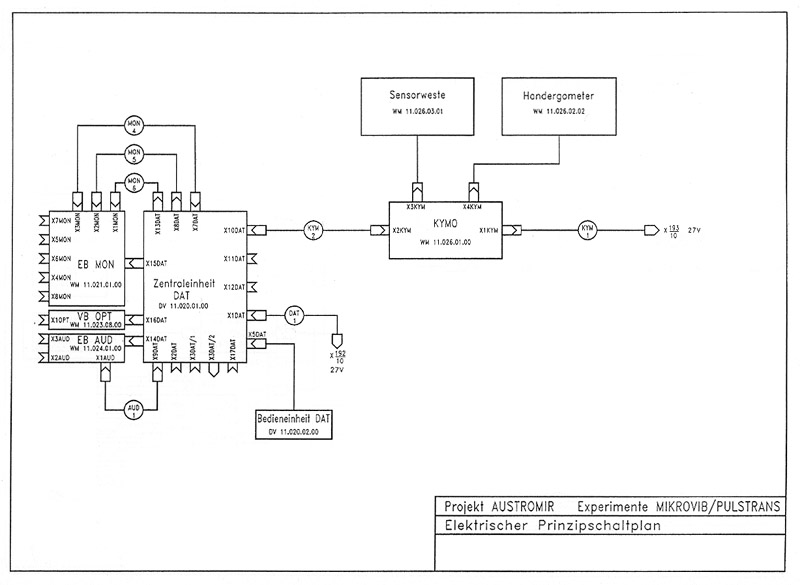
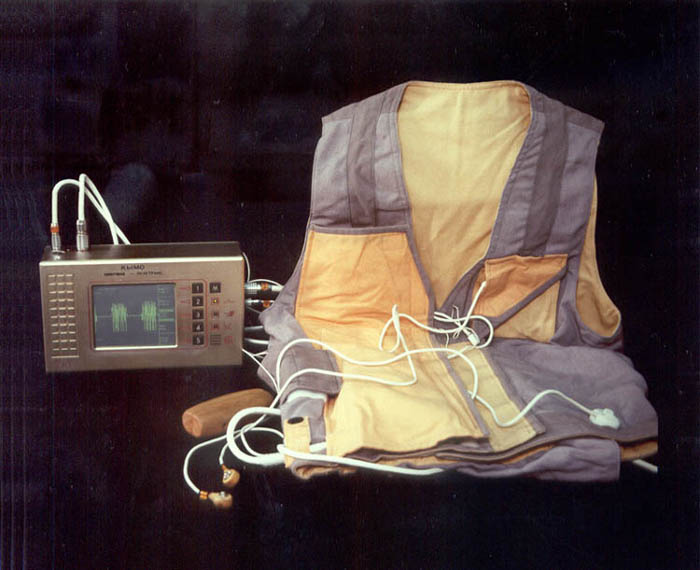
Aluminium container with foam coating
- Equipment KYMO
- Cable KYM1 (Power supply)
- Cable KYM2 (Connection KYMO – DATAMIR)
- Sensor vest with
Vibrostimulator
Accelerometer (2 pieces)
Puls sensores (3 pieces)
ECG – cable
Pre-amplifier unit - Hand ergometer
- Accessory sets for the experiment MIKROVIB (2 pieces)
Adherance rings (3 pieces), Adherance discs (6 pieces)
Cleaning tissues (2 pieces), ECG – Electrodes (3 pieces) - Accessory sets for the experiment PULSTRANS (2 pieces)
Adherance rings (3 pieces), Adherance discs (6 pieces)
Cleaning tissues (2 pieces), ECG – Electrodes (3 pieces) - Accessory sets for the experiment SLEEP (2 pieces)
Adherance rings (3 pieces), Adherance discs (6 pieces)
Cleaning tissues (2 pieces), ECG – Electrodes (3 pieces) - Fixing devices for the puls sensors (3 pieces)
- Adhesive tapes to fix the vibrostimulator and
accelerometer on the skin of the subject - Jig for the standardised fixation of vibrostimulator and
accelerometer on the skin of the subject - Reserve assurance
| Mass: | max. 6.2 kg |
| Dimensions: | 350 mm x 350 mm x 140 mm |
| Power input: | max. 35 W |
- Apparatus KYMO-2 (used in the Phase RLF-3)
- (1) Microprocessor unit (Experiment conduction, Data recording)
- (2) Measurement belt for bodysignals (Accelerometer, EKG, respiration)
- (3) Puls- and ballistocardiography-sensorvest
- (4) Force measurement: hand dynamometer
- (5) Force measurement: pedestal dynamometer with EMG-system
- (6) Cervical clip for the carotid puls sensor
- (7) Force measurement: expander
- (8) Sensor for the respiratory pressure with mouthpieces
- (9) Cable (Mains supply, board computer
- (X) Transport container
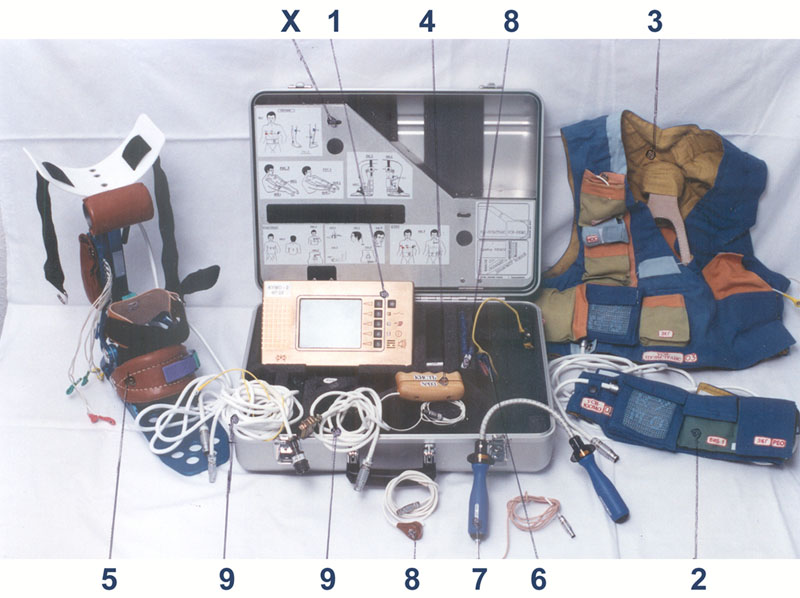
- Measurement belt for body signals
- (1) Cotton jacket (dilatable except about 25 cm, hook-and-loop fastener)
- (2) triaxial-accelerometer
- (3) Finger puls sensor
- (4) Elektrodes for EKG and impedance plethysmography
- (5) Analogue module to edit all signals
- (6) Connecting cable with a plug for the computer
- (7) Cord grip
- (8) Fixation for the movement measurement during sleep
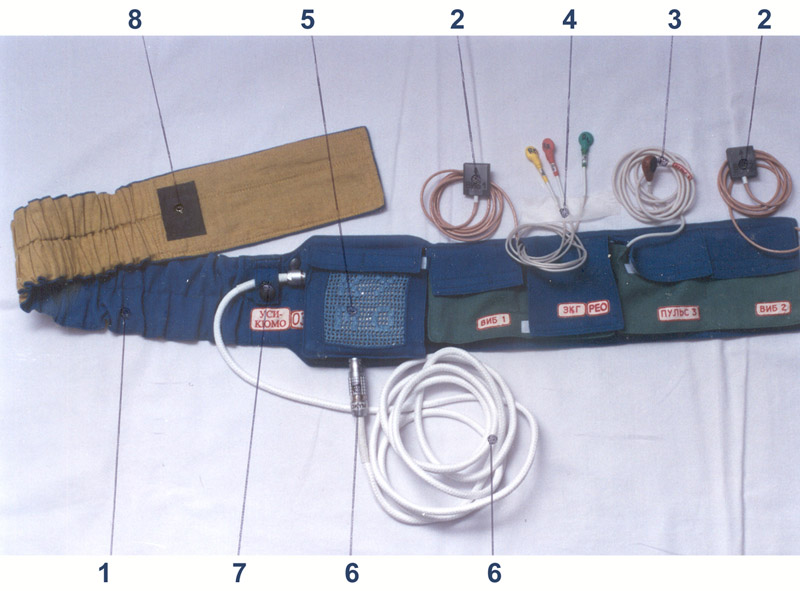
Experimenters
Univ.-Prof. Dr. Thomas Kenner (institute manager)
Univ.-Prof. Dr. Maximilian Moser (project manager)
Dr. Hans Zeiringer
Dipl.-Ing. Matthias Frühwirth
Dr. Magdalena Voica
Ing. Dietmar Messerschmidt
Dipl.-Ing. Thomas Niederl
Dipl.-Ing. Bernhard Schaffer
Dr. Franziska Muhry
Mag. Manfred Lux
Univ.-Prof. DDr. Michael Lehofer
all: Physiological Institute of the University Graz
Univ.-Prof. Dr. Roman Markovic Baevskij
Dr. Irina Isajevna Funtova
A. G. Chemikova
V. N. Zhevnov
all: IMBP (Institute for Biomedical Problems), Moscow
